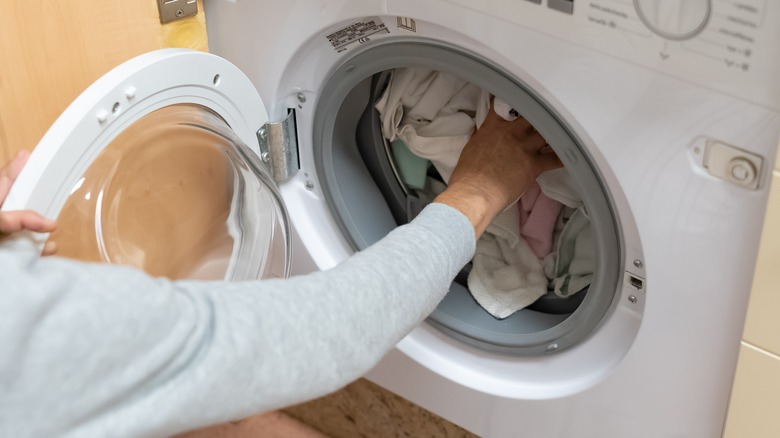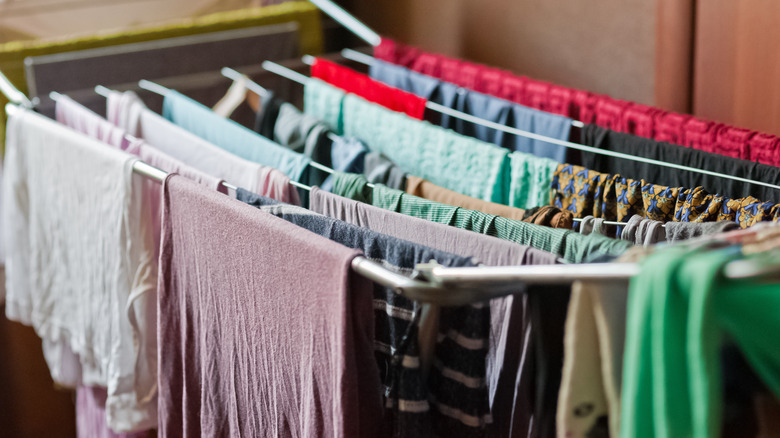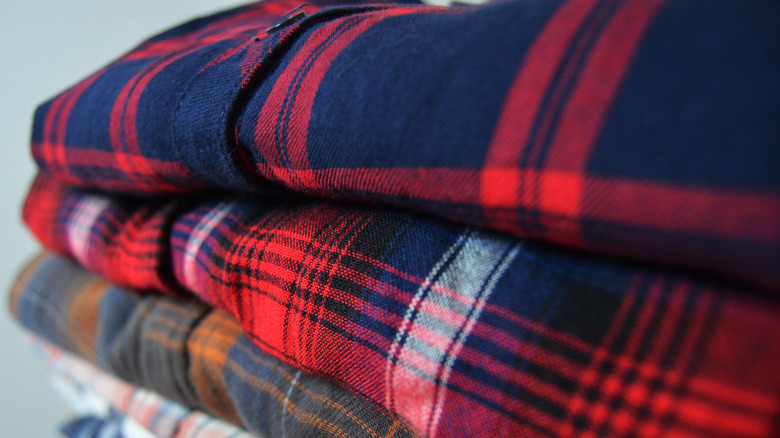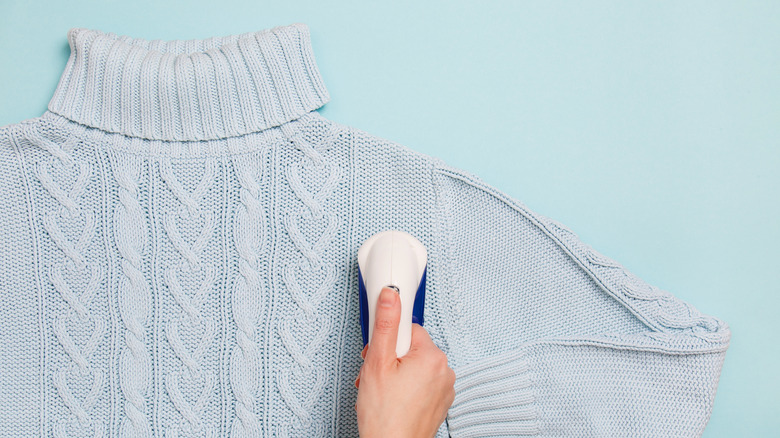How To Keep Your Flannel Fashions In Tip-Top Shape
Flannel, a humble, typically plaid-printed fabric that dates all the way back to Wales in the 16th century, has seen quite the development throughout history into the cold-weather staple we know and love today (via Lands' End). In the 17th and 18th centuries, it slowly spread its way through the rest of Europe, eventually making its mark in the United States in the late 19th century. It first gained speed in America as an alternative to less rugged wool garments during the Industrial Revolution, popular with loggers and railway workers facing long, grueling hours on the job.
Its early ties to blue collar workers quickly made the flannel shirt into a symbol of Americana and masculine strength, and its association with cowboys and lumberjacks of lore only further developed the connection. In the '90s, however, it was co-opted by grunge icons of the time as a part of their minimalist, understated style. Since then, flannel shirts have grown into a cozy staple for any gender, age, and occupation, but even a fabric as sturdy and popular as this needs some special care instructions to ensure it lasts and remains soft for years to come.
Wash gently
The best way to ensure your garments last is by taking a look at the care label and following the instructions closely, but it's rare that we check every single item of clothing before tossing it in the wash. Despite its rugged connotations, as a general rule, flannel should be either hand-washed or washed on a gentle cycle in cool or warm water along with other, more fragile fabrics like silk, lace, and satin.
Flannel might not deteriorate or rip as easily as your favorite slip dress, but a gentle cycle helps to prevent pilling and preserve the integrity of the fabric so you can wear it for years to come. It's also a good idea to skip on the fabric softener, even if you're trying to make a new shirt feel more worn in. Over time, fabric softener will coat the fibers of your flannel instead of sinking in and washing away, only making it feel more rough and stiff.
Air dry, if possible
You should treat your flannels like fragile fabrics in the washer, but the same care extends to the dryer. The goal in caring for your flannels is to reduce friction as much as possible to prevent pilling, so air drying can seriously cut down the amount of time your fabric is rubbing against other items of clothing. If you need your flannel to dry quickly, however, you can still toss it in the dryer on a low heat or tumble dry setting occasionally.
Stay away from dryer sheets as they can cause a similar coating to fabric softener, and instead reach for dryer balls that can help separate clothes and reduce static, per Massage Naturals. Keeping it on the lowest heat setting possible is also necessary because flannel, like other fabrics made out of natural fibers, has a tendency to shrink and weaken with high heat. Overall, it's best to avoid any harsh treatment entirely, even if flannel is seen as a strong, durable fabric.
Avoid excess friction
One of the main issues that people face with their beloved flannel shirts is pilling. This bumpy, unsightly texture is caused by fibers breaking and forming into tiny balls with friction. A bit of pilling, especially around high-friction areas like under the arms, is common. This might happen more with lower-quality fabrics, but even high-quality flannel is prone to these little balls because of the nature of this construction (via REI). Anything designed to be fuzzy or soft is more prone to this compared to more sleek options like nylon.
The best way to reduce the chances of your garment pilling is by reducing friction. Constant rubbing of bags, jackets, and other accessories can cause your flannels to pill, but in some cases, this is unavoidable unless you keep your favorite shirt hidden at the back of your closet. Following the garment's proper care instructions can help prevent the issue from worsening, and washing with like colors can even help disguise pills and make them look less obvious.
Invest in a fabric shaver
Even if you treat your flannels exactly according to the garment's care instructions, you'll likely still deal with a bit of pilling. That's where the quiet hero — the fabric shaver — comes in. These convenient little devices remove pills without damaging the actual fabric, and can work on anything from your favorite plaid button down to a full flannel sheet set. Most options are under $20, likely less than the cost of your shirt itself, and can significantly extend the life of your most-worn pieces, per Put This On.
If you'd rather not make any additional purchases, you can also use a fresh disposable razor to remove pills in a pinch. Look for a cheap razor without any bells and whistles like moisturizing strips, then lay your shirt flat and hold the fabric taught. Gently shave away the pills, just like you would hair, and tap off fuzz between swipes. This is a bit more of a DIY approach, but it still does the job, especially if you're just tackling one or two shirts.
Continue wearing them routinely
The best-feeling flannels are almost always decades-old, well-loved pieces, so the best way to get your favorite plaid shirt to feel buttery soft is deceptively simple — just wear it. If you properly take care of the fabric with gentle washing and drying, your high-quality flannel will hold up for years to come, giving you the chance to break it in until its one of the most comfortable pieces in your closet.
If you really want to speed up the process, you can add a splash of vinegar to your laundry cycle to help soften up the texture a bit, but nothing beats age and use when it comes to achieving the most comfortable flannel possible. A bit of wear and tear will help work out the stiffness of the fabric and leave you with a perfectly-soft shirt, ideal for wearing on its own or layering with jackets and other pieces in the colder months.





